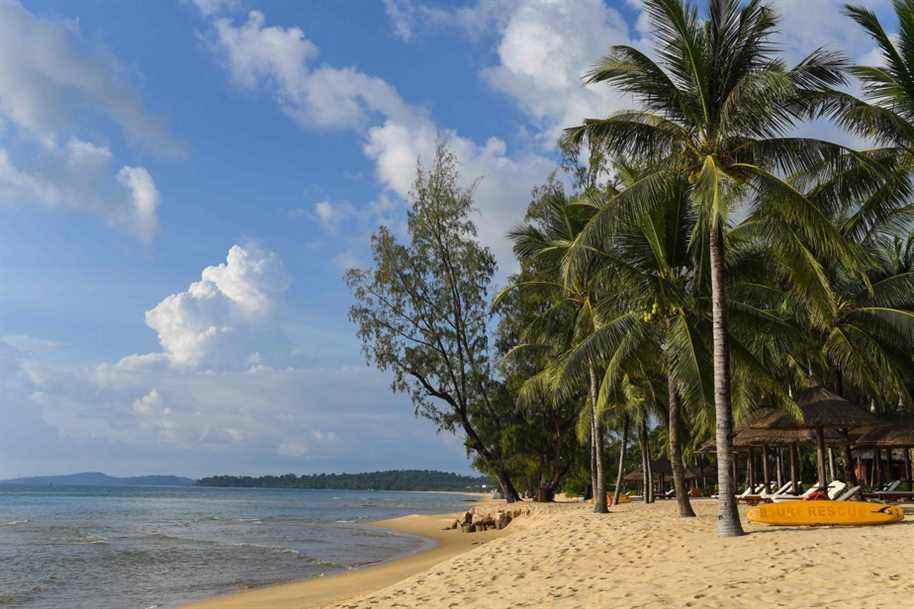(Phu Quoc) Thousands of hotel rooms, a cable car with Guinness Records, a miniature Venice: the Vietnamese island of Phu Quoc, which reopened to international tourism on Saturday, took advantage of the pandemic to accelerate its development, high risk concreting for tropical paradise.
Some 200 South Koreans were the first foreign visitors in 20 months to land on the island, nestled a stone’s throw from Cambodia, in the crystal-clear waters of the Gulf of Thailand.
“This is the first time that I have left South Korea since the start of the health crisis […] I feel safe. We are all vaccinated, ”Tae Hyeong Lee told AFP.
The group will stay in a 12,000-room resort, can ride a gondola, get giddy on the amusement park rides, kick the ball on a pristine 18-hole course, feed the giraffes at the safari zoo and play roulette in the a casino worthy of Las Vegas.
“I am so excited to welcome our first visitors,” enthuses Ngo Thi Bich Thuong, employee of the gigantic complex, called Phu Quoc United Center.
On more than 1,000 hectares and kilometers of coastline in the northwest of the island, it opened its doors six months ago, in the midst of a pandemic.
The powerful Vietnamese conglomerate VinGroup (construction, tourism, automobile, shopping centers, education, etc.) has invested $ 2.8 billion in the project.
The ambitions of the group of billionaire Phạm Nhật Vượng are great: to make Phu Quoc “a new international destination on the world tourist map”.
40,000 hotel rooms

PHOTO NHAC NGUYEN, FRANCE-PRESS AGENCY
“In all, 40,000 hotel rooms have been built, are planned or under construction,” said Ken Atkinson, vice-chairman of the Vietnamese Tourism Advisory Board. “It’s more hotel keys than in Sydney.”
Concreting is spreading elsewhere on the island.
“In all, 40,000 hotel rooms have been built, are planned or under construction,” said Ken Atkinson, vice-chairman of the Vietnamese Tourism Advisory Board. “It’s more hotel keys than in Sydney.”
In the south, another developer, Sun Group, has invested in leisure parks and a cable car of almost 8 kilometers, one of the longest in the world, registered in the Guinness World Records.
“The Emerald Isle” has long remained away from tourist circuits, devoting itself to fishing, green pepper cultivation and pearl farming.
Nature is so flourishing there that in 2006 it was classified as a “world biosphere reserve” by UNESCO.
But the white sand beaches do not take long to attract investors who dream of making it a new Phuket, the Thai island which welcomed ten million international visitors in 2019.
In 2012, an international airport was opened in Phu Quoc. Seven years later, five million tourists, including more than 500,000 foreigners – Chinese, Russians, Japanese, South Koreans – flood the beaches.
“Plastic flood”

PHOTO NHAC NGUYEN, FRANCE-PRESS AGENCY
“More and more visitors are aware of the environment, they will not want to go to litter-strewn beaches or swim in a sea polluted by sewage,” warns Ken Atkinson, vice-chairman of the Advisory Board of the Vietnamese tourism.
Even if part of the island remains classified as a protected area, this rapid development is worrying.
“Phuket has taken years to grow, but Vietnam tends to want to do everything at once,” laments Ken Atkinson. “I don’t think enough attention is being paid to what would be in Phu Quoc’s long-term interest.”
The crystal-clear waters are teeming with coral reefs and the beaches were once popular nesting grounds for endangered green turtles and hawksbill turtles.
No nesting has taken place in recent years, noted UNESCO in 2018.
And the plastic waste generated by tourism has already had a disastrous effect on the ecosystem.
Before the pandemic, around 160 tonnes of garbage was being generated every day, according to the World Wide Fund for Nature (WWF).
The organization denounced “an almost unimaginable deluge of plastic” which threatened marine life. It warned against “inappropriate” waste management in the face of the explosion in tourism.
“More and more visitors are aware of the environment, they will not want to go to beaches strewn with rubbish or swim in a sea polluted by sewage,” warns Ken Atkinson.
But residents, cut off from the financial windfall of foreign tourists for months, are eager to see business pick up again.
“If Phu Quoc did not develop, it would only be an undiscovered pearl”, estimates Chu Dinh Duc, who has set up a small hotel structure away from the gigantic complexes.
Lai Chi Phuc, tour guide, is also anxiously awaiting the return of visitors.
“Everyone wanted to escape from Phu Quoc when I was a child,” recalls the 33-year-old, who spent a long time working on the mainland. “Thanks to the tourists, I was finally able to return to my island”.
